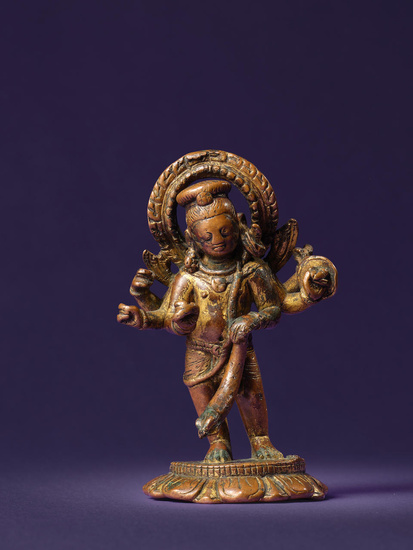A GILT COPPER ALLOY FIGURE OF A DANDAPURUSHA NEPAL, CIRCA...
A GILT COPPER ALLOY FIGURE OF A DANDAPURUSHA
NEPAL, CIRCA 9TH CENTURY
Himalayan Art Resources item no. 1894
12 cm (4 5/8 in.) high
尼泊爾 約九世紀 銅鎏金神祇像
This gilt bronze of a six-armed male deity charmingly imagines him as an adolescent with plump features and a youthful exuberance. He wears a short loincloth reminiscent of those worn by wrestlers in conjunction with a sacred thread that wraps over his left shoulder and around his right thigh. Also embellishing his head is a set of asymmetrical earrings and a flat-topped pile of hair held in place by a single band. His hairstyle and physiognomy are similar in form to a unique emanation of Hayagriva that is published in von Schroeder, Buddhist Sculptures in Tibet, Vol. I, 2001, pp. 472-3, nos. 147B-D. The present lot most likely represents the deification of the attribute known as a Dandapurusha, based on the vajra-tipped club (or danda) and the circular shield with a rosette design that he holds in two of his hands. The flaming mandorla radiating around his head, the billowing scarf mimicking the wings of an eagle, and the lotus flower cushioning his feet are also shared by a figure of Vajrapurusha as the personified thunderbolt (see Pal, Asian Art at the Norton Simon Museum: Art from the Himalayas & China, 2003, p. 74, no. 43). What is more certain, however, is that the figure's attentive care for well over a millennia has contributed to the warm, luxuriant glow of its reddish surface interspersed with traces of gilding.
The Nepalese mode of anthropomorphizing attributes is characteristic of bronzes from the Licchavi period (c. 5th–9th centuries), whose Newari craftsmen formed close contacts with major artistic centers like Mathura and Sarnath that fell within the territories of the Gupta Empire. For other examples of Nepalese bronzes with similar proportions but of slightly later dating, see a figure of Vatuka Bhairava (Pal, Nepal: Where the Gods are Young, 1975, p. 96, no. 63); a dwarf-like figure of Yama pressing his knee on the head of a water buffalo in the Ashmolean Museum, Oxford (Heller, Early Himalayan Art, 2008, pp. 54-5, no. 6); and a figure of the goddess Devi sold in Bonhams, New York, 14 March 2016, lot 18.
Provenance
Carlo Cristi, 2017
A Distinguished Asian Collector
View it on
Sale price
Estimate
Time, Location
Auction House
A GILT COPPER ALLOY FIGURE OF A DANDAPURUSHA
NEPAL, CIRCA 9TH CENTURY
Himalayan Art Resources item no. 1894
12 cm (4 5/8 in.) high
尼泊爾 約九世紀 銅鎏金神祇像
This gilt bronze of a six-armed male deity charmingly imagines him as an adolescent with plump features and a youthful exuberance. He wears a short loincloth reminiscent of those worn by wrestlers in conjunction with a sacred thread that wraps over his left shoulder and around his right thigh. Also embellishing his head is a set of asymmetrical earrings and a flat-topped pile of hair held in place by a single band. His hairstyle and physiognomy are similar in form to a unique emanation of Hayagriva that is published in von Schroeder, Buddhist Sculptures in Tibet, Vol. I, 2001, pp. 472-3, nos. 147B-D. The present lot most likely represents the deification of the attribute known as a Dandapurusha, based on the vajra-tipped club (or danda) and the circular shield with a rosette design that he holds in two of his hands. The flaming mandorla radiating around his head, the billowing scarf mimicking the wings of an eagle, and the lotus flower cushioning his feet are also shared by a figure of Vajrapurusha as the personified thunderbolt (see Pal, Asian Art at the Norton Simon Museum: Art from the Himalayas & China, 2003, p. 74, no. 43). What is more certain, however, is that the figure's attentive care for well over a millennia has contributed to the warm, luxuriant glow of its reddish surface interspersed with traces of gilding.
The Nepalese mode of anthropomorphizing attributes is characteristic of bronzes from the Licchavi period (c. 5th–9th centuries), whose Newari craftsmen formed close contacts with major artistic centers like Mathura and Sarnath that fell within the territories of the Gupta Empire. For other examples of Nepalese bronzes with similar proportions but of slightly later dating, see a figure of Vatuka Bhairava (Pal, Nepal: Where the Gods are Young, 1975, p. 96, no. 63); a dwarf-like figure of Yama pressing his knee on the head of a water buffalo in the Ashmolean Museum, Oxford (Heller, Early Himalayan Art, 2008, pp. 54-5, no. 6); and a figure of the goddess Devi sold in Bonhams, New York, 14 March 2016, lot 18.
Provenance
Carlo Cristi, 2017
A Distinguished Asian Collector



